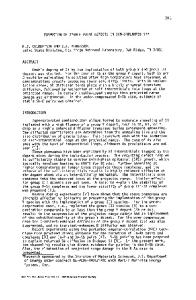Formation and Effects of Secondary Defects in Ion implanted Silicon
- PDF / 7,298,482 Bytes
- 15 Pages / 417.6 x 639 pts Page_size
- 63 Downloads / 386 Views
Inc.
209
FORMATION AND EFFECTS OF SECONDARY DEFECTS IN ION IMPLANTED SILICON
Jack Washburn Department of Engineering and Lawrence Berkeley Laboratory, University of California, Berkeley, California 94720
ABSTRACT The clustering of isolated interstitial silicon, implanted atoms, and vacant lattice sites produced by low temperature and room temperature ion implantation during subsequent annealing is reviewed. An electron microscope method for studying the kinetics of the amorphous to crystalline transformation in silicon is described. The technique is applied to measurement of the activation energy for interface migration and the formation of microtwins for different growth directions. A very brief review of the effects of laser annealing after ion implantation is included.
INTRODUCTION Because of its flexibility in providing desired dopant distributions and because undesirable impurity diffusion accompanying high temperature treatments can be minimized, ion implantation has become increasingly utilized for fabrication of solid state devices. Ion implanatation is also interesting from a basic science viewpoint. The concomitant radiation damage is severe and recovers to give a fascinating diversity of secondary defects. These secondary defects can adversely affect electrical propeties. Consequently, ion implantation conditions and post implantation annealing procedures which avoid formation of secondary defects are desirable. When a foreign atom is injected into a silicon crystal with an energy of -100 KeV, it generally comes to rest in an interstitial space or as part of an interstitial complex with one or more of the far more numerous displaced silicon atoms. As long as it remains in such a special site it does not give rise to the desired donor or acceptor level: it is electrically inactive. Post implantation annealing decreases the density of special sites gradually increasing the number of implanted atoms that occupy regular substitational sites. A recent alternative to post implantation annealing is so called laser annealing which in reality is not annealing but rather liquid phase epitaxial regrowth of the surface layers of the wafer in an extremely sharp temperature gradient. The technique has the advantage that heating of the wafer is almost entirely confined to the surface layers, thus avoiding diffusion of impurities in the underlying part of the wafer. This paper is a brief review of the nature of some commonly observed secondary defects in silicon and the mechanisms of their formation. Because other papers in this volume focus major attention on laser "annealing," effects very little will be included here. Space limitations also make a complete cataloging of all known kinds of secondary defects impossible. The discussion will be limited to implantation of boron and phosphoros in silicon.
210 Growth and Effects of Secondary Defects During implantation and in the low temperature post-implantation annealing range below 600°C silicon interstitials and the implanted atoms which are also in interstitial
Data Loading...


